Self-Assessment Report (SAR) for Annual Internal Ranking (AIR) of Govt. Colleges of Himachal Pradesh for the Academic Session 2023-24
| Self-Assessment Report (SAR) -2023-24 | Link |
|---|
| Criterion 1- Teaching Learning | ||
|---|---|---|
| Metric | Activity | Link |
| 1.1 Mode of Teaching | ||
| 1.1.1 | Lecture method only | Link |
| 1.1.2 | Technology based teaching only or Blended Teaching | Link |
| 1.1.3 | Flipped Classroom | Link |
| 1.1.4 | As per the need of different groups of Students | Empty |
| 1.2 Curriculum Planning and Implementation | ||
| 1.2.1 | Teaching Schedule | Link |
| 1.2.2 | Whether learning outcomes defined | Link |
| 1.2.3 | Curriculum Enrichment Practices (eg. Projects, Surveys, Educational tours and Industry visits) | Link |
| 1.2.4 | Internal Assessment Mechanism (Quizzes, Class tests, Presentations, Assignments, MTT etc.) | Link |
| 1.2.5 | Prompt communication of assessment/ results to students (eg. Displayed on College Website/ Notice Board/ Class Groups/ Submitted to COE | Link |
| 1.3 Add-on Courses/ Certificate Courses | ||
| 1.3.1 | Number of Courses (To be specified separately) | Link |
| 1.3.2 | %age of students benefited (%age of students completed MOOCs/ Spoken Tutorial/ NPTEL/ Other courses offered by recognized organizations | Link |
| 1.4 Student Feedback (Taken from students with 80% attendance) | ||
| 1.4.1 | Sample size | Link |
| 1.4.2 | Student’s satisfaction | Link |
| 1.4.3 | Action on Feedback | Link |
| 1.5 Examination Results | ||
| 1.5.1 | %age of Students Passed | Link |
| 1.5.2 | %age of Students with A Grade and above | Link |
| 1.5.3 | Number of Students in University Merit | Link |
| Criterion 2- Student Support, Services and Progression | ||
| 2.1 Pre and Post-Admission Counseling | ||
| 2.1.1 | Admission Schedule, Courses available, Student Intake, Eligibility conditions communicated through various Media | Link |
| 2.1.2 | Pre-admission Counseling | Link |
| 2.1.3 | Students oriented about: Institution, Students Facilities, Library, Introductory session with Faculty and Staff, Academic Calendar, Requirement of Credits per Course, CCA and other requirements Post-admission | Link |
| 2.2 Scholarships | ||
| 2.2.1 | Awareness about different Scholarship Schemes and 100% coverage of all eligible students | Link |
| 2.2.2 | Scholarships other than Government Schemes | Link |
| 2.3 Sports and Cultural Activities | ||
| 2.3.1 | %age of Students participating in Sports Activities | Link |
| 2.3.2 | %age of Students participating in Cultural Activities | Link |
| 2.3.3 | Medal/ Trophy won in Sports/ Cultural activities a. National/ Inter-University b. State/ Inter-College c. District level (also includes cluster level) | Link |
| 2.4 Students Participating in NSS/ NCC/ Rovers & Rangers/ Clubs & Societies | ||
| 2.4.1 | NSS | Link |
| 2.4.2 | NCC | Link |
| 2.4.3 | Rovers & Rangers | Link |
| 2.4.4 | Road Safety | Link |
| 2.4.5 | Red Ribbon/ Eco Club/ Youth Red Cross/ and other Clubs & Societies | Link |
| 2.5 NSS/ NCC/ Rovers & Rangers participating in: | ||
| 2.5.1 | National Camps/ RD Parade | Link |
| 2.5.2 | State Camps/ Parade | Link |
| 2.5.3 | Award won in these activities a. National b. State c. Cluster level | Link |
| 2.6 Anti-Drug Awareness Programmes | ||
| 2.6.1 | Number of Awareness Programmed organized | Link |
| 2.6.2 | %age of Students benefited | Link |
| 2.6.3 | Counseling of suspected addicts | Empty |
| 2.7 Gender Equity | ||
| 2.7.1 | Number of Health/ sensitization Programmes organized | Link |
| 2.7.2 | %age of Students benefited | Link |
| 2.7.3 | Women Anti-Sexual Harassment Committee constituted as per norms | Link |
| 2.7.4 | Grievance Redressal as per timeline | Link |
| 2.8 Mentor-Mentee Groups | ||
| 2.8.1 | Sessions conducted per group of students | Link |
| 2.9 | Coaching for National level Competitive Examinations/ HAS | Link |
| 2.10 Remedial Classes/ Bridge Courses | ||
| 2.10.1 | %age of Students benefited | Empty |
| 2.11 Capacity Building of Students | ||
| 2.11.1 | Life Skills (Yoga, Martial Arts, Problem Solving, Critical Thinking, Decision Making, Effective Communication Skills, Coping with Stress and Emotions etc. | Link |
| 2.11.2 | Language-cum-Graduate Attributes Development programmes | Link |
| 2.12 Career Counseling & Placement Cell | ||
| 2.12.1 | Number of Career Counseling Sessions organized for each group of Students | Link |
| 2.12.2 | Number of Placement Drives | Link |
| 2.12.3 | Self-Employment Modules organized | Link |
| 2.12.4 | Number of Students benefited | Link |
| 2.13 Student’s Progression | ||
| 2.13.1 | %age of Students opted for Higher Education | Link |
| 2.13.2 | Number of Students who cleared National Level Examination (IAS, CDS, OTA, JAM, NET etc.) and HAS, AP through HPPSC | Link |
| 2.14 Number of Co-curricular and Sports Activities organized | ||
| 2.14.1 | Inter-University Events (Zonal/ National) | Empty |
| 2.14.2 | Inter-College Events | Link |
| 2.14.3 | Intra-College Events (Annual Athletic Meet and Cultural Functions) | Link |
| 2.15 | Annual Prize Distribution organized: (Yes/ No) | Link |
| 2.16 | College Magazine Published: (Yes/ No) | Link |
| 2.17 | College Website updated regularly or not | Link |
| Criterion 3- Infrastructure & Resources | ||
| 3.1 Classrooms | ||
| 3.1.1 | Classrooms are well maintained | Link |
| 3.2 Library Facilities | ||
| 3.2.1 | Whether adequate print books available | Link |
| 3.2.2 | Whether daily Newspapers (minimum 5), Magazines (minimum 3), and Journals (minimum 3) are available | Link |
| 3.2.3 | Whether access to e-Resources available | Link |
| 3.2.4 | Seating Capacity in the Library | Link |
| 3.2.5 | Usage of Library Resources | Link |
| 3.2.6 | Digital Library having at least 5 computer systems with Internet Facility | Link |
| 3.3 ICT Facilities | ||
| 3.3.1 | Number of Interactive Panels/ Virtual Classrooms Multimedia, Projectors/ K-Yan | Link |
| 3.3.2 | %age of Teachers using ICT Facilities | Link |
| 3.3.3 | Number of Students benefited from ICT Facilities | Link |
| 3.3.4 | Internet Connections- Leased Line/ Fiber Network/ Wi-Fi Campus (Yes/ No) | Link |
| 3.3.5 | Use of ICT Facilities | Link |
| 3.4 Facilities for Specially-abled Students | ||
| 3.4.1 | Ramps/ Wheel Chairs/ Support Railing | Link |
| 3.4.2 | Separate Washroom | Link |
| 3.5 Sports Facilities | ||
| 3.5.1 | Number of Games/ Sports activities conducted | Link |
| 3.5.2 | Indoor Sports Facility | Link |
| 3.5.3 | Adequate Sports Equipments | Link |
| 3.5.4 | Gymnasium (Operational) | Link |
| 3.6 | Auditorium/ Hostels/ Seminar Hall/ Staff Quarters | Link |
| 3.7 Laboratory Facilities | ||
| 3.7.1 | Laboratories with adequate equipment according to syllabi | Link |
| 3.7.2 | Usage of available Lab Infrastructure | Link |
| 3.8 Computers | ||
| 3.8.1 | Adequate number of Computers | Link |
| 3.8.2 | Usage of Computer Hardware | Link |
| 3.9 | Canteen, Staff Room/ Faculty Room, Space for NSS, NCC, Rovers & Rangers, Examination Room, Medical Care Facilities | Link |
| 3.10 | Documentation of Academic, Co-curricular and extra-curricular activities, and achievement of Students and Staff on regular basis | Link |
| Criterion 4 Institutional management | ||
| 4.1 Institutional Vision | ||
| 4.1.1 | Vision Document | Link |
| 4.1.2 | Institutional Development Plan (IDP) | Link |
| 4.1.3 | Plan of Action for above | Link |
| 4.2 IQAC | ||
| 4.2.1 | Number of Meetings per year | Link |
| 4.2.2 | Number of Programmes organized (Trainings, Workshops, IPR etc.) | Link |
| 4.3 Management of Institutional Funds | ||
| 4.3.1 | Funds (BF, AF, PTA etc.) used/ spent for Institutional Development/ Student’s Welfare | Link |
| 4.3.2 | Periodic Audit | Link |
| 4.3.3 | Settlement of Bills/ Advances within a specified time frame | Link |
| 4.4 Grievance Redressal of Students and Employees | ||
| 4.4.1 | Redressal within a week | Link |
| 4.4.2 | Redressal within a month | Empty |
| 4.4.3 | No Redressal | Empty |
| 4.5 Green and Clean Campus | ||
| 4.5.1 | Green Initiatives of Institution (at least 3) | Link |
| 4.5.2 | Cleanliness in washroom, Buildings and Campus | Link |
| 4.6 Facilities for Students | ||
| 4.6.1 | Common Room for Girls | Link |
| 4.6.2 | Adequate Toilets as per Student’s strength | Link |
| 4.6.3 | Sanitary Napkin Vending Machines/ Incinerators regularly put in use | Link |
| 4.6.4 | CSCA Room with proper furniture | Link |
| 4.6.5 | Student Centre for Co-curricular activities and its regular usage | Link |
| 4.6.6 | Regular use of Playground | Link |
| 4.7 | Regular Updation of Service Books/ Service Records | Link |
| 4.8 | Timely submission of ACRs | Link |
| 4.9 | Prompt Response to Official Correspondence | Link |
| 4.10 | Proper Maintenance of Official Records (Cash Books/ Stock Registers, Fund Registers, Leave Records, Fine Fund etc.) | Empty |
| 4.11 | Proper Record of Student’s Attendance and CCA | Link |
| 4.12 | Whether ranked by NIRF, other Agencies | Link |
| 4.13 | Whether accredited by NAAC | Link |
| 4.14 | Whether AQARs are being submitted as per time line annually or not | Link |
| 4.15 | Recognition for Exemplary Contributions of the Staff and Students | Link |
| 4.16 Involvement of Stakeholders | ||
| 4.16.1 | PTA | Link |
| 4.16.2 | OSA | Link |
| 4.17 | Feedback from Stakeholders other than Students and action taken there on | Link |
| 4.18 | Annual Review Meeting on Student’s Outcomes in Academics, Co-curricular, Extra-Curricular and Extension Activities and action taken during next Academic Session for achieving Excellence | Link |
| Criterion 5- Best Practices, Innovation and Institutional Distinctiveness | ||
| 5.1 | Best Practices Description & Outcome of Best Practices (at least two) | Link |
| 5.2- Special Initiatives taken for: | ||
| 5.2.1 | Energy Conservation/ Use of Solar Energy | Link |
| 5.2.2 | Solid Waste Segregation/ Management | Link |
| 5.2.3 | Rainwater Harvesting and its use for Gardening and Cleanliness | Link |
| 5.2.4 | Plastic Free Campus | Link |
| 5.2.5 | Blood Donation Camps | Link |
| 5.2.6 | Adoption of Villages/ Educational Institutions | Link |
| 5.3 | Social Impact of Extension Activities (On the basis of Community Feedback) | Link |
| 5.4 | Special New Innovative Initiatives or Ideas Adopted in the College (Other than 5.2 given above) | Link |
| 5.5 Collaborations | ||
| 5.5.1 | With Peer Educational/ Research Institutions | Link |
| 5.5.2 | With other Government Bodies/ Industries | Link |
| Criterion 6 Faculty Profile & Research Activities | ||
| 6.1 | %age of Teachers with Ph.D | Link |
| 6.2 | Teachers as Research Guides | Link |
| 6.3 | Number of Orientation Programmes, Refresher Courses, Faculty Development Programmes and Workshops of one week or more attended by Teachers (in last three years) | Link |
| 6.4 Projects/ Patents/ Fellowships/ Associateships: | ||
| 6.4.1 | Major | Link |
| 6.4.2 | Minor | Link |
| 6.4.3 | Patents | Link |
| 6.4.4 | Fellowships | Link |
| 6.4.5 | Associateships | Link |
| 6.5 Number of Papers Presented in Conferences/ Seminars/ Symposia (in last three years) | ||
| 6.5.1 | International level | Link |
| 6.5.2 | National/ Regional/ State level | Link |
| 6.6 Seminars, Workshops, Conferences and Trainings organized by the Institution | ||
| 6.6.1 | International level | Link |
| 6.6.2 | National level | Link |
| 6.6.3 | State level | Link |
| 6.7 Number of Papers Published | ||
| 6.7.1 | UGC Care list Journals | Link |
| 6.7.2 | Non-UGC Care list Journals | Link |
| 6.7.3 | Citations | Link |
| 6.8 | Teacher’s Special Innovative Ideas (brief description thereof) | Link |
| 6.9 | Number of Books Published/ Chapters in Books | Link |
| 6.10 Teacher’s Academic and Extension activities | ||
| 6.10.1 | Resource Person | Link |
| 6.10.2 | Member of Board of Studies/ Subject experts etc. | Link |
| 6.10.3 | Popular Articles | Empty |
| 6.11 Awards by Recognized & Reputed Organizations | ||
| 6.11.1 | International | Link |
| 6.11.2 | National | Link |
| 6.11.3 | State | Link |
| Criterion 7 Miscellaneous | ||
| 7.1 | Any other Important Information or Initiative not covered above eg. Institution Incubation Centre, R&D-cum-Innovation Centre, B.Voc., Sel Finance Courses, Add-on Courses, Internship, OJT, Green Audit, Academic Audit etc. | Link |
| 7.2 | Spot Evaluation of Institutions by the Officers from the Directorate of Higher Education/ Representatives of the Director of Higher Education | Link |
| 7.3 | AG Audit Paras settled up to date | Link |
| 7.4 | Local Audit Paras settles up to date | Link |
| 7.5 | Timeline adhered to filing reply of Court Cases/ RTI Applications/ Public Grievances received through Mukhyamantri Seva Sankalp 1100 and Centralized Public Grievance Redress and Monitoring System (CPGRAMS) | Link |
| 7.6 | Invited Speakers on various Themes relevant to holistic development of Students | Link |
| 7.7 | Skill Development Training (at least 20% Students benefited) | Link |
Other Links
Address
Maharana Pratap Govt. Degree College, Amb
Distt : Una, Himachal pradesh
Pin-177203
Phone: 01976-260032
Email: govtcollegeamb@gmail.com
Distt : Una, Himachal pradesh
Pin-177203
Phone: 01976-260032
Email: govtcollegeamb@gmail.com

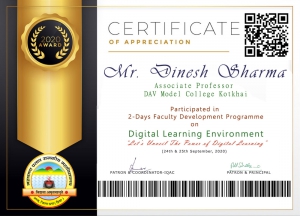 Participant Detail Mr. Dinesh Sharma Associate Professor DAV Model College Kotkhai Session Details Participant present in all the sessions on 24th & 25th September, 2020. Barcode ID Mr. Dinesh SharmaMPGCAMBfdp2020p01
Participant Detail Mr. Dinesh Sharma Associate Professor DAV Model College Kotkhai Session Details Participant present in all the sessions on 24th & 25th September, 2020. Barcode ID Mr. Dinesh SharmaMPGCAMBfdp2020p01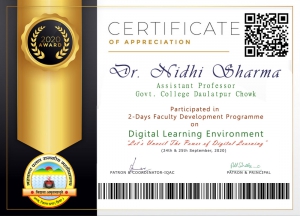 Participant Detail Dr. Nidhi Sharma Assistant Professor Govt. College Daulatpur Chowk Session Details Participant present in all the sessions on 24th & 25th September, 2020. Barcode ID Dr. Nidhi SharmaMPGCAMBfdp2020p02
Participant Detail Dr. Nidhi Sharma Assistant Professor Govt. College Daulatpur Chowk Session Details Participant present in all the sessions on 24th & 25th September, 2020. Barcode ID Dr. Nidhi SharmaMPGCAMBfdp2020p02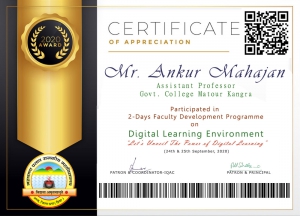 Participant Detail Mr. Ankur Mahajan Assistant Professor Govt. College Matour Kangra Session Details Participant present in all the sessions on 24th & 25th September, 2020. Barcode ID Mr. Ankur MahajannMPGCAMBnfdp2020p03
Participant Detail Mr. Ankur Mahajan Assistant Professor Govt. College Matour Kangra Session Details Participant present in all the sessions on 24th & 25th September, 2020. Barcode ID Mr. Ankur MahajannMPGCAMBnfdp2020p03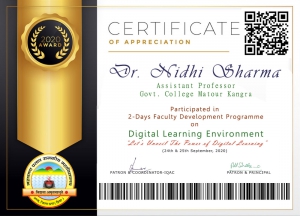 Participant Detail Dr. Nidhi Sharma Assistant Professor Govt. College Matour Kangra Session Details Participant present in all the sessions on 24th & 25th September, 2020. Barcode ID Dr. Nidhi SharmaMPGCAMBfdp2020p04
Participant Detail Dr. Nidhi Sharma Assistant Professor Govt. College Matour Kangra Session Details Participant present in all the sessions on 24th & 25th September, 2020. Barcode ID Dr. Nidhi SharmaMPGCAMBfdp2020p04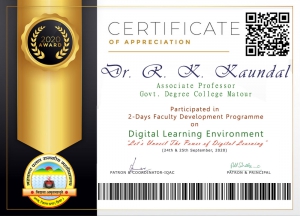 Participant Detail Dr. R. K. Kaundal Associate Professor Govt. Degree College Matour Session Details Participant present in all the sessions on 24th & 25th September, 2020. Barcode ID Dr. R. K. KaundalMPGCAMBfdp2020p05
Participant Detail Dr. R. K. Kaundal Associate Professor Govt. Degree College Matour Session Details Participant present in all the sessions on 24th & 25th September, 2020. Barcode ID Dr. R. K. KaundalMPGCAMBfdp2020p05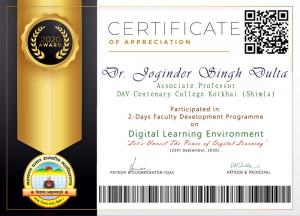 Participant Detail Dr. Joginder Singh Dulta Associate Professor DAV Centenary College Kotkhai (Shimla) Session Details Participant present in last 2 sessions on 25th September, 2020. Barcode ID Dr. Joginder Singh DultaMPGCAMBfdp2020p06
Participant Detail Dr. Joginder Singh Dulta Associate Professor DAV Centenary College Kotkhai (Shimla) Session Details Participant present in last 2 sessions on 25th September, 2020. Barcode ID Dr. Joginder Singh DultaMPGCAMBfdp2020p06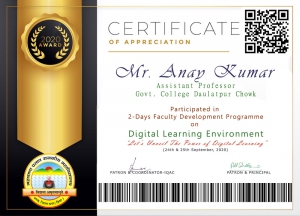 Participant Detail Dr. Nidhi Sharma Assistant Professor Govt. College Matour Kangra Session Details Participant present in all the sessions on 24th & 25th September, 2020. Barcode ID Dr. Nidhi SharmaMPGCAMBfdp2020p04
Participant Detail Dr. Nidhi Sharma Assistant Professor Govt. College Matour Kangra Session Details Participant present in all the sessions on 24th & 25th September, 2020. Barcode ID Dr. Nidhi SharmaMPGCAMBfdp2020p04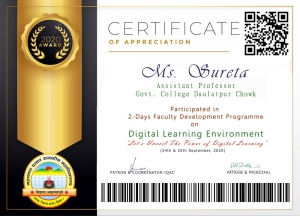 Participant Detail Dr. Nidhi Sharma Assistant Professor Govt. College Matour Kangra Session Details Participant present in all the sessions on 24th & 25th September, 2020. Barcode ID Dr. Nidhi SharmaMPGCAMBfdp2020p04
Participant Detail Dr. Nidhi Sharma Assistant Professor Govt. College Matour Kangra Session Details Participant present in all the sessions on 24th & 25th September, 2020. Barcode ID Dr. Nidhi SharmaMPGCAMBfdp2020p04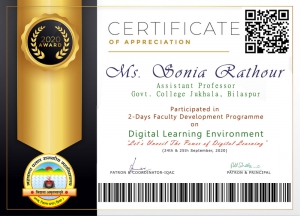 Participant Detail Ms. Sonia Rathour Assistant Professor Govt. College Jukhala, Bilaspur Session Details Participant present in all the sessions on 24th & 25th September, 2020. Barcode ID Ms. Sonia RathourMPGCAMBfdp2020p10
Participant Detail Ms. Sonia Rathour Assistant Professor Govt. College Jukhala, Bilaspur Session Details Participant present in all the sessions on 24th & 25th September, 2020. Barcode ID Ms. Sonia RathourMPGCAMBfdp2020p10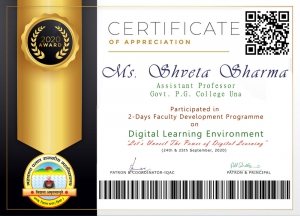 Participant Detail Ms. Shveta Sharma Assistant Professor Govt. P.G. College Una Session Details Participant present in all the sessions on 24th & 25th September, 2020. Barcode ID Ms. Shveta SharmaMPGCAMBfdp2020p11
Participant Detail Ms. Shveta Sharma Assistant Professor Govt. P.G. College Una Session Details Participant present in all the sessions on 24th & 25th September, 2020. Barcode ID Ms. Shveta SharmaMPGCAMBfdp2020p11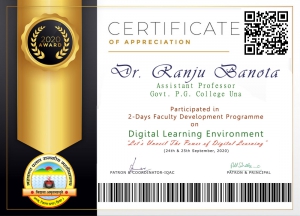 Participant Detail Dr. Ranju Banota Assistant Professor Govt. P.G. College Una Session Details Participant present in all the sessions on 24th & 25th September, 2020. Barcode ID Dr. Ranju BanotaMPGCAMBfdp2020p12
Participant Detail Dr. Ranju Banota Assistant Professor Govt. P.G. College Una Session Details Participant present in all the sessions on 24th & 25th September, 2020. Barcode ID Dr. Ranju BanotaMPGCAMBfdp2020p12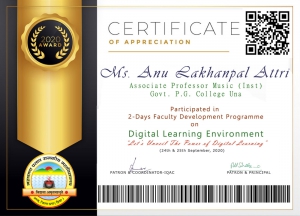 Participant Detail Ms. Anu Lakhanpal Attri Associate Professor Music (Inst) Govt. P.G. College Una Session Details Participant present in all the sessions on 24th & 25th September, 2020. Barcode ID Ms. Anu Lakhanpal AttriMPGCAMBfdp2020p13
Participant Detail Ms. Anu Lakhanpal Attri Associate Professor Music (Inst) Govt. P.G. College Una Session Details Participant present in all the sessions on 24th & 25th September, 2020. Barcode ID Ms. Anu Lakhanpal AttriMPGCAMBfdp2020p13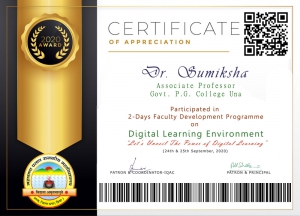 Dr. Sumiksha Associate Professor Govt. P.G. College Una
Dr. Sumiksha Associate Professor Govt. P.G. College Una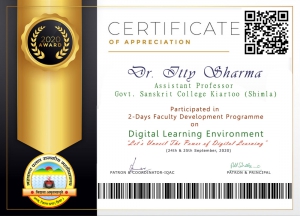 Participant Detail Dr. Itty Sharma Assistant Professor Govt. Sanskrit College Kiartoo Shimla Session Details Participant present in all the sessions on 24th & 25th September, 2020. Barcode ID Itty SharmaMPGCAMBfdp2020p15
Participant Detail Dr. Itty Sharma Assistant Professor Govt. Sanskrit College Kiartoo Shimla Session Details Participant present in all the sessions on 24th & 25th September, 2020. Barcode ID Itty SharmaMPGCAMBfdp2020p15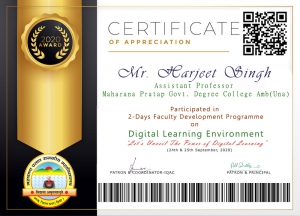 Participant Detail
Mr. Harjeet Singh
Assistant Professor
Maharana Pratap Govt. Degree College Amb (Una)
Session Details
Participant present in all the sessions on 24th & 25th September, 2020.
Barcode ID
Mr. Harjeet SinghMPGCAMBfdp2020p16
Participant Detail
Mr. Harjeet Singh
Assistant Professor
Maharana Pratap Govt. Degree College Amb (Una)
Session Details
Participant present in all the sessions on 24th & 25th September, 2020.
Barcode ID
Mr. Harjeet SinghMPGCAMBfdp2020p16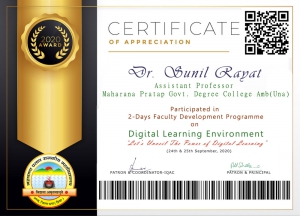 Participant Detail
Dr. Sunil Rayat
Assistant Professor
Maharana Pratap Govt. Degree College Amb (Una)
Session Details
Participant present in all the sessions on 24th & 25th September, 2020.
Barcode ID
Dr. Sunil RayatMPGCAMBfdp2020p17
Participant Detail
Dr. Sunil Rayat
Assistant Professor
Maharana Pratap Govt. Degree College Amb (Una)
Session Details
Participant present in all the sessions on 24th & 25th September, 2020.
Barcode ID
Dr. Sunil RayatMPGCAMBfdp2020p17
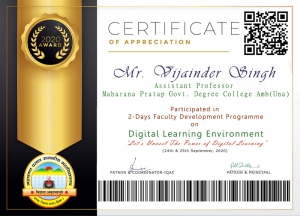 Participant Detail
Mr. Vijainder Singh
Assistant Professor
Maharana Pratap Govt. Degree College Amb (Una)
Session Details
Participant present in all the sessions on 24th & 25th September, 2020.
Barcode ID
Mr. Vijainder SinghMPGCAMBfdp2020p18
Participant Detail
Mr. Vijainder Singh
Assistant Professor
Maharana Pratap Govt. Degree College Amb (Una)
Session Details
Participant present in all the sessions on 24th & 25th September, 2020.
Barcode ID
Mr. Vijainder SinghMPGCAMBfdp2020p18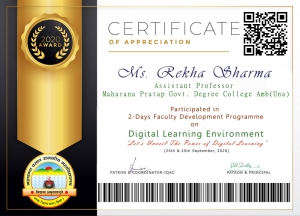 Participant Detail Ms. Rekha Sharma Assistant Professor Maharana Pratap Govt. Degree College Amb (Una) Session Details Participant present in all the sessions on 24th & 25th September, 2020. Barcode ID Ms. Rekha SharmaMPGCAMBfdp2020p19
Participant Detail Ms. Rekha Sharma Assistant Professor Maharana Pratap Govt. Degree College Amb (Una) Session Details Participant present in all the sessions on 24th & 25th September, 2020. Barcode ID Ms. Rekha SharmaMPGCAMBfdp2020p19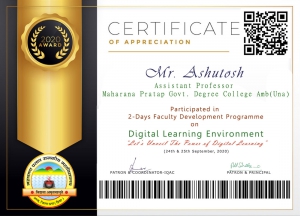 Participant Detail Mr. Ashutosh Assistant Professor Maharana Pratap Govt. Degree College Amb (Una) Session Details Participant present in all the sessions on 24th & 25th September, 2020. Barcode ID Mr. AshutoshMPGCAMBfdp2020p20
Participant Detail Mr. Ashutosh Assistant Professor Maharana Pratap Govt. Degree College Amb (Una) Session Details Participant present in all the sessions on 24th & 25th September, 2020. Barcode ID Mr. AshutoshMPGCAMBfdp2020p20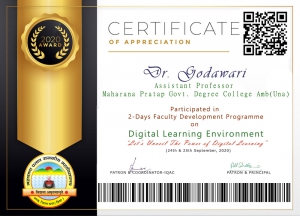 Participant Detail Dr. Godawari Assistant Professor Maharana Pratap Govt. Degree College Amb (Una) Session Details Participant present in all the sessions on 24th & 25th September, 2020. Barcode ID Dr. GodawariMPGCAMBfdp2020p21
Participant Detail Dr. Godawari Assistant Professor Maharana Pratap Govt. Degree College Amb (Una) Session Details Participant present in all the sessions on 24th & 25th September, 2020. Barcode ID Dr. GodawariMPGCAMBfdp2020p21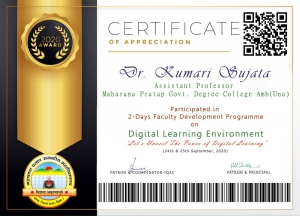 Participant Detail Dr. Kumari Sujata Assistant Professor Maharana Pratap Govt. Degree College Amb (Una) Session Details Participant present in all the sessions on 24th & 25th September, 2020. Barcode ID Dr. Kumari SujataMPGCAMBfdp2020p22
Participant Detail Dr. Kumari Sujata Assistant Professor Maharana Pratap Govt. Degree College Amb (Una) Session Details Participant present in all the sessions on 24th & 25th September, 2020. Barcode ID Dr. Kumari SujataMPGCAMBfdp2020p22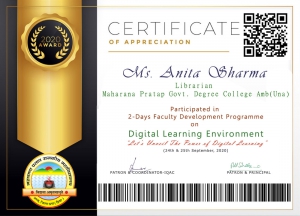 Participant Detail
Ms. Anita Sharma
Librarian
Maharana Pratap Govt. Degree College Amb (Una)
Session Details
Participant present in all the sessions on 24th & 25th September, 2020.
Barcode ID
Ms. Anita SharmaMPGCAMBfdp2020p23
Participant Detail
Ms. Anita Sharma
Librarian
Maharana Pratap Govt. Degree College Amb (Una)
Session Details
Participant present in all the sessions on 24th & 25th September, 2020.
Barcode ID
Ms. Anita SharmaMPGCAMBfdp2020p23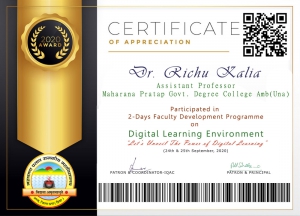 Participant Detail
Dr. Richu Kalia
Assistant Professor
Maharana Pratap Govt. Degree College Amb (Una)
Session Details
Participant present in all the sessions on 24th & 25th September, 2020.
Barcode ID
Dr. Richu KaliaMPGCAMBfdp2020p24
Participant Detail
Dr. Richu Kalia
Assistant Professor
Maharana Pratap Govt. Degree College Amb (Una)
Session Details
Participant present in all the sessions on 24th & 25th September, 2020.
Barcode ID
Dr. Richu KaliaMPGCAMBfdp2020p24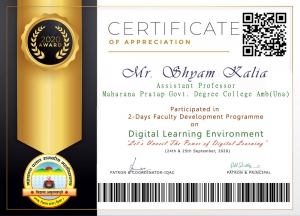 Participant Detail Mr. Shyam Kalia Assistant Professor Maharana Pratap Govt. Degree College Amb (Una) Session Details Participant present in all the sessions on 24th & 25th September, 2020. Barcode ID Mr. Shyam KaliaMPGCAMBfdp2020p25
Participant Detail Mr. Shyam Kalia Assistant Professor Maharana Pratap Govt. Degree College Amb (Una) Session Details Participant present in all the sessions on 24th & 25th September, 2020. Barcode ID Mr. Shyam KaliaMPGCAMBfdp2020p25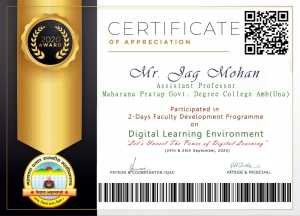 Participant Detail Mr. Jag Mohan Assistant Professor Maharana Pratap Govt. Degree College Amb (Una) Session Details Participant present in all the sessions on 24th & 25th September, 2020. Barcode ID Mr. Jag MohanMPGCAMBfdp2020p26
Participant Detail Mr. Jag Mohan Assistant Professor Maharana Pratap Govt. Degree College Amb (Una) Session Details Participant present in all the sessions on 24th & 25th September, 2020. Barcode ID Mr. Jag MohanMPGCAMBfdp2020p26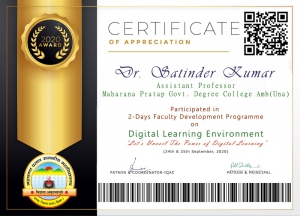 Participant Detail
Dr. Satinder Kumar
Assistant Professor
Maharana Pratap Govt. Degree College Amb (Una)
Session Details
Participant present in all the sessions on 24th & 25th September, 2020.
Barcode ID
Dr. Satinder KumarMPGCAMBfdp2020p27
Participant Detail
Dr. Satinder Kumar
Assistant Professor
Maharana Pratap Govt. Degree College Amb (Una)
Session Details
Participant present in all the sessions on 24th & 25th September, 2020.
Barcode ID
Dr. Satinder KumarMPGCAMBfdp2020p27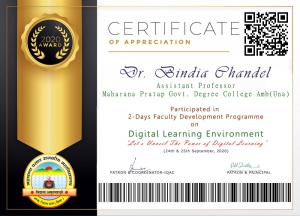 Participant Detail Dr. Bindia Chandel Assistant Professor Maharana Pratap Govt. Degree College Amb (Una) Session Details Participant present in all the sessions on 24th & 25th September, 2020. Barcode ID Dr. Bindia ChandelMPGCAMBfdp2020p28
Participant Detail Dr. Bindia Chandel Assistant Professor Maharana Pratap Govt. Degree College Amb (Una) Session Details Participant present in all the sessions on 24th & 25th September, 2020. Barcode ID Dr. Bindia ChandelMPGCAMBfdp2020p28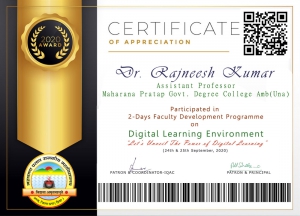 Participant Detail Dr. Rajneesh Kumar Assistant Professor Maharana Pratap Govt. Degree College Amb (Una) Session Details Participant present in all the sessions on 24th & 25th September, 2020. Barcode ID Dr. Rajneesh KumarMPGCAMBfdp2020p29
Participant Detail Dr. Rajneesh Kumar Assistant Professor Maharana Pratap Govt. Degree College Amb (Una) Session Details Participant present in all the sessions on 24th & 25th September, 2020. Barcode ID Dr. Rajneesh KumarMPGCAMBfdp2020p29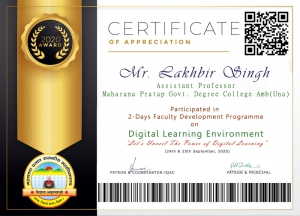 Participant Detail
Mr. Lakhbir Singh
Assistant Professor
Maharana Pratap Govt. Degree College Amb (Una)
Session Details
Participant present in all the sessions on 24th & 25th September, 2020.
Barcode ID
Mr. Lakhbir SinghMPGCAMBfdp2020p30
Participant Detail
Mr. Lakhbir Singh
Assistant Professor
Maharana Pratap Govt. Degree College Amb (Una)
Session Details
Participant present in all the sessions on 24th & 25th September, 2020.
Barcode ID
Mr. Lakhbir SinghMPGCAMBfdp2020p30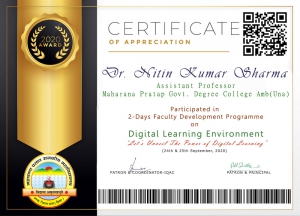 Participant Detail
Dr. Nitin Kumar Sharma
Assistant Professor
Maharana Pratap Govt. Degree College Amb (Una)
Session Details
Participant present in all the sessions on 24th & 25th September, 2020.
Barcode ID
Dr. Nitin Kumar SharmaMPGCAMBfdp2020p31
Participant Detail
Dr. Nitin Kumar Sharma
Assistant Professor
Maharana Pratap Govt. Degree College Amb (Una)
Session Details
Participant present in all the sessions on 24th & 25th September, 2020.
Barcode ID
Dr. Nitin Kumar SharmaMPGCAMBfdp2020p31
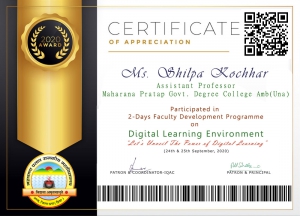 Participant Detail
Ms. Shilpa Kochhar
Assistant Professor
Maharana Pratap Govt. Degree College Amb (Una)
Session Details
Participant present in all the sessions on 24th & 25th September, 2020.
Barcode ID
Ms. Shilpa KochharMPGCAMBfdp2020p32
Participant Detail
Ms. Shilpa Kochhar
Assistant Professor
Maharana Pratap Govt. Degree College Amb (Una)
Session Details
Participant present in all the sessions on 24th & 25th September, 2020.
Barcode ID
Ms. Shilpa KochharMPGCAMBfdp2020p32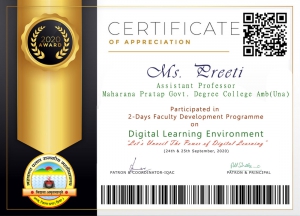 Participant Detail Ms. Preeti Assistant Professor Maharana Pratap Govt. Degree College Amb (Una) Session Details Participant present in all the sessions on 24th & 25th September, 2020. Barcode ID Ms. PreetiMPGCAMBfdp2020p33
Participant Detail Ms. Preeti Assistant Professor Maharana Pratap Govt. Degree College Amb (Una) Session Details Participant present in all the sessions on 24th & 25th September, 2020. Barcode ID Ms. PreetiMPGCAMBfdp2020p33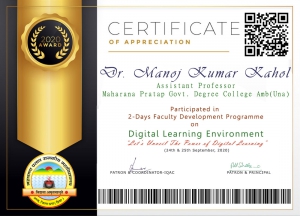 Participant Detail Dr. Manoj Kumar Kahol Assistant Professor Maharana Pratap Govt. Degree College Amb (Una) Session Details Participant present in all the sessions on 24th & 25th September, 2020. Barcode ID Dr. Manoj Kumar KaholMPGCAMBfdp2020p36
Participant Detail Dr. Manoj Kumar Kahol Assistant Professor Maharana Pratap Govt. Degree College Amb (Una) Session Details Participant present in all the sessions on 24th & 25th September, 2020. Barcode ID Dr. Manoj Kumar KaholMPGCAMBfdp2020p36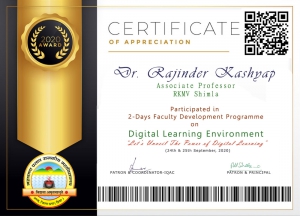 Participant Detail
Dr. Rajinder Kashyap
Associate Professor
RKMV Shimla
Session Details
Participant present in all the sessions on 24th & 25th September, 2020.
Barcode ID
Dr. Rajinder KashyapMPGCAMBfdp2020p37
Participant Detail
Dr. Rajinder Kashyap
Associate Professor
RKMV Shimla
Session Details
Participant present in all the sessions on 24th & 25th September, 2020.
Barcode ID
Dr. Rajinder KashyapMPGCAMBfdp2020p37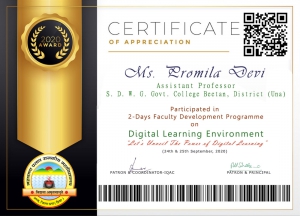 Participant Detail
Ms. Promila Devi
Assistant Professor
S. D. W. G. Govt. College Beetan, District Una(H.P)
Session Details
Participant present in all the sessions on 24th & 25th September, 2020.
Barcode ID
Ms. Promila DeviMPGCAMBfdp2020p39
Participant Detail
Ms. Promila Devi
Assistant Professor
S. D. W. G. Govt. College Beetan, District Una(H.P)
Session Details
Participant present in all the sessions on 24th & 25th September, 2020.
Barcode ID
Ms. Promila DeviMPGCAMBfdp2020p39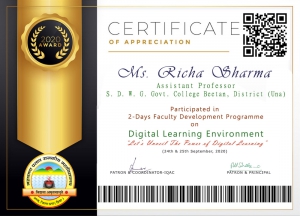 Participant Detail Ms. Richa Sharma Assistant Professor S. D. W. G. Govt. College Beetan, District Una(H.P) Session Details Participant present in all the sessions on 24th & 25th September, 2020. Barcode ID Ms. Richa SharmaMPGCAMBfdp2020p38
Participant Detail Ms. Richa Sharma Assistant Professor S. D. W. G. Govt. College Beetan, District Una(H.P) Session Details Participant present in all the sessions on 24th & 25th September, 2020. Barcode ID Ms. Richa SharmaMPGCAMBfdp2020p38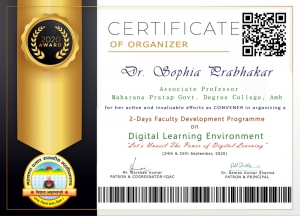 Organizer's Detail Dr. Sophia Prabhakar Associate Professor Maharana Pratap Govt. Degree College, Amb Session Details Organizer present in all the sessions on 24th & 25th September, 2020. Barcode ID Dr. Sophia Prabhakar\MPGCAMB\FDP2020O03
Organizer's Detail Dr. Sophia Prabhakar Associate Professor Maharana Pratap Govt. Degree College, Amb Session Details Organizer present in all the sessions on 24th & 25th September, 2020. Barcode ID Dr. Sophia Prabhakar\MPGCAMB\FDP2020O03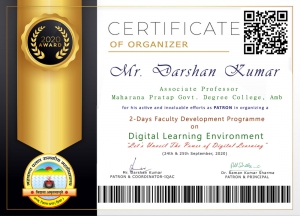 Organizer's Detail Mr. Darshan Kumar Associate Professor Maharana Pratap Govt. Degree College, Amb FDP-Patron Session Details Organizer present in all the sessions on 24th & 25th September, 2020. Barcode ID Mr. Darshan Kumar\MPGCAMB\FDP2020O02
Organizer's Detail Mr. Darshan Kumar Associate Professor Maharana Pratap Govt. Degree College, Amb FDP-Patron Session Details Organizer present in all the sessions on 24th & 25th September, 2020. Barcode ID Mr. Darshan Kumar\MPGCAMB\FDP2020O02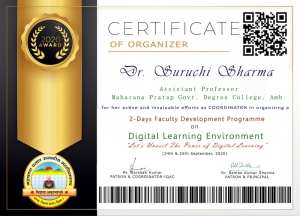 Organizer's Detail Dr. Suruchi Sharma Assistant Professor Maharana Pratap Govt. Degree College, Amb FDP-Coordinator Session Details Organizer present in all the sessions on 24th & 25th September, 2020. Barcode ID Dr. Suruchi Sharma\MPGCAMB\FDP2020O05
Organizer's Detail Dr. Suruchi Sharma Assistant Professor Maharana Pratap Govt. Degree College, Amb FDP-Coordinator Session Details Organizer present in all the sessions on 24th & 25th September, 2020. Barcode ID Dr. Suruchi Sharma\MPGCAMB\FDP2020O05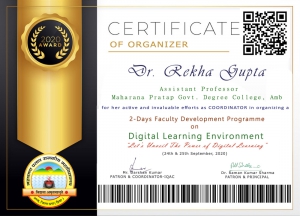 Participant Detail Ms. Richa Sharma Assistant Professor S. D. W. G. Govt. College Beetan, District Una(H.P) Session Details Participant present in all the sessions on 24th & 25th September, 2020. Barcode ID Ms. Richa SharmaMPGCAMBfdp2020p38
Participant Detail Ms. Richa Sharma Assistant Professor S. D. W. G. Govt. College Beetan, District Una(H.P) Session Details Participant present in all the sessions on 24th & 25th September, 2020. Barcode ID Ms. Richa SharmaMPGCAMBfdp2020p38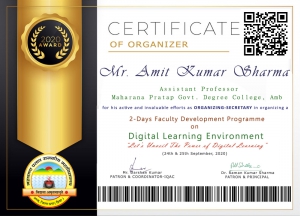 Organizer's Detail Mr. Amit Kumar Sharma Assistant Professor Maharana Pratap Govt. Degree College, Amb FDP-Organizing Secretary Session Details Organizer present in all the sessions on 24th & 25th September, 2020. Barcode ID Mr. Amit Kumar Sharma\MPGCAMB\FDP2020O07
Organizer's Detail Mr. Amit Kumar Sharma Assistant Professor Maharana Pratap Govt. Degree College, Amb FDP-Organizing Secretary Session Details Organizer present in all the sessions on 24th & 25th September, 2020. Barcode ID Mr. Amit Kumar Sharma\MPGCAMB\FDP2020O07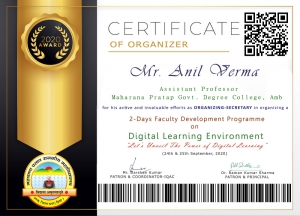 Organizer's Detail Mr. Anil Verma Assistant Professor Maharana Pratap Govt. Degree College, Amb FDP-Organizing Secretary Session Details Organizer present in all the sessions on 24th & 25th September, 2020. Barcode ID Mr. Anil Verma\MPGCAMB\FDP2020O08
Organizer's Detail Mr. Anil Verma Assistant Professor Maharana Pratap Govt. Degree College, Amb FDP-Organizing Secretary Session Details Organizer present in all the sessions on 24th & 25th September, 2020. Barcode ID Mr. Anil Verma\MPGCAMB\FDP2020O08